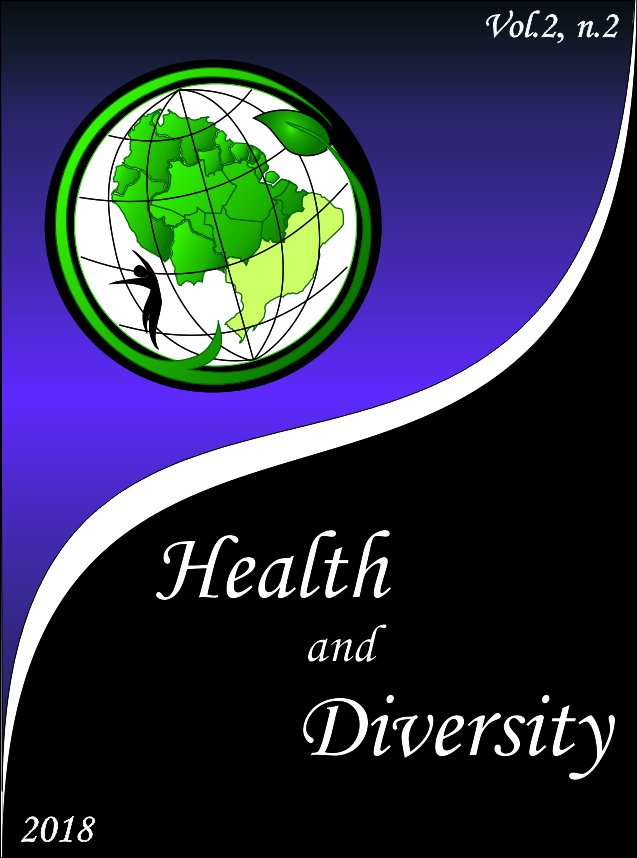Epidemiologic analysis of malaria cases in the triple border Brazil-Venezuela-Guyana from 2010 to 2017
DOI:
https://doi.org/10.18227/hd.v2i2.7508Keywords:
Malaria, border, Roraima, Venezuela, GuyanaAbstract
Introduction: Malaria is an infectious disease considered a global health issue. In Brazil, thanks to public policies, the notified cases of malaria have diminished, but this is not the reality in the northern region of the country, especially in the state of Roraima, that for sharing borders with two other countries, Venezuela and Guyana, shows peculiar nosogeographic characteristics that make it hard for the disease’s eradication. Objective: Analyze the epidemiology of malaria in the triple border Brazil-Venezuela-Guyana, from 2010 to 2017, and how borders can set a favorable environment for the disease’s spread. Methods: bibliographic revision, WHO reports, data obtained from the Malaria’s Epidemiological Vigilance Information System. Obtained information has been analyzed and organized with computer programs such as Microsoft® Office Excel 2016 e TabWin v. 3.6b. Development: In Roraima, while most autochthonous cases tend to reduce, imported cases from Venezuela and Guyana tend to increase and reduce cyclically, depending on many factors, such as migration waves and public investment in health care. Most imported cases notified in Roraima are originated from Venezuela, what can be explained by the uncontrolled and intense immigration from this country. Conclusion: The obtained data reveal the necessity of more attention towards these border regions, of improvement of the epidemiological vigilance systems and the professionals responsible for its operation, better quality of health assistance in the border regions, with the participation of specialists in malaria and the involvement of the local population in health care and prevention.
Downloads
References
BRASIL. Ministério da Saúde, Portal da Saúde. Departamento de Informática do SUS (DATASUS) –Informações de Saúde (TABNET). Disponível na Internet em: http://www2.datasus.gov.br/DATASUS/index.php?area=02. (acesso em: 04/10/2018).
BRASIL. Ministério da Saúde, Secretaria de Vigilância em Saúde. Sistema de Informação de Vigilância Epidemiológica – Notificação de Casos de Malária (SIVEP-Malária). Balanço 2010 a 2017. Disponível na Internet em: www.saude.gov.br/sivep_malaria. (acesso em: 04/10/2018).
CHAVES, S. S.; RODRIGUES, L. C. An initial examination of the epidemiology of malaria in the State of Roraima, in the Brazilian Amazon Basin. Revista do Instituto de Medicina Tropical de São Paulo, v. 42, n. 5, p. 269–275, out. 2000.
FARRAR, J. et al. Manson’s Tropical Infectious Diseases 23rd edition. Saunders, Elsevier, 2014.
FENG, J. et al. Ready for malaria elimination: zero indigenous case reported in the People’s Republic of China. Malaria journal, v. 17, n. 1, p. 315, 29 ago. 2018.
FONTES, M. S. Recursos naturais nas Relações Internacionais: O precedente do Brasil na Segunda Guerra Mundial. Revista Internacional de História Política e Cultura Jurídica, Rio de Janeiro: vol. 7, no 1, janeiro-abril, p. 109-132, 2015.
GRIFFING, S. M. et al. A historical perspective on malaria control in Brazil. Memórias do Instituto Oswaldo Cruz, v. 110, n. 6, p. 701, 2015.
GRILLET, M. E. et al. Malaria in Venezuela requires response. Science, v. 359, n. 6375, p. 528.1-528, 2 fev. 2018.
HIPÓCRATES. Aforismos. São Paulo: Martin Claret, 2003. WILLIAMS, J. The ethics of territorial borders: drawing lines in the shifting sand. [S.l.]: Palgrave Macmillan, 2006.
Instituto Brasileiro de Geografia e Estatística. Panorama de Boa Vista – Roraima. Disponível na Internet em: https://cidades.ibge.gov.br/brasil/rr/boa-vista/panorama. (acesso em: 14/08/2018).
JORDANO, D. Efeitos das mudanças climáticas aumentam casos de malária na Amazônia. Ciência para todos. v.1, n.5. p. 28-33, ago. 2010.
MARCHAO, T. Venezuelanos sobrecarregam postos de saúde na fronteira com Roraima. [online]. Disponível na Internet em: https://noticias.uol.com.br/internacional/ultimas-noticias/2018/03/04/busca-por-atendimentomedico-na-fronteira-sobrecarrega-a-pequena-pacaraima.htm. (acesso em: 05/10/2018).
OLIVEIRA, J. M. et al. Caracterização epidemiológica da malária em Roraima no período de 2006 a 2016. Health and Diversity, v. 1, no 2, p. 104-108.
OLIVEIRA-FERREIRA, J. et al. Malaria in Brazil: an overview. Malaria journal, v. 9, p. 115, 30 abr. 2010.
Organização Mundial da Saúde. World Malaria Report 2017. http://www.who.int/malaria/publications/worldmalaria-report-2017/report/en/. (acesso em 27.07.2018).
PARKER, D. M. et al. Malaria ecology along the Thailand-Myanmar border. Malaria journal, v. 14, p. 388, 5 out. 2015.
PARKER, D. M. et al. Malaria ecology along the Thailand-Myanmar border. Malaria journal, v. 14, p. 388, 5 out. 2015.
PEITER, P. C. et al. Situação da malária na tríplice fronteira entre Brasil, Colômbia e Peru. Cadernos de Saúde Pública, v. 29, n. 12, p. 2497–2512, dez. 2013.
PEITER, P. et al. Doenças transmissíveis na faixa de fronteira Amazônica: o caso da malária. Território, ambiente e saúde, p. 257–272, 2008.
PONTES, C. J. A guerra no inferno verde: o segundo ciclo da borracha, o front da amazônia e os soldados da borracha. South American Journal of Basic Education, Technical and Technological, INSS: 2446-4821, vol. 2, no 1, p. 56-67, 2015.
SAMPAIO, V. S. et al. Malaria in the State of Amazonas: a typical Brazilian tropical disease influenced by waves of economic development. Revista da Sociedade Brasileira de Medicina Tropical, v. 48, n. suppl 1, p. 4–11, jun. 2015.
SILVA-VASCONCELOS, A. da et al. Biting Indices, Hostseeking Activity and Natural Infection Rates of Anopheline Species in Boa Vista, Roraima, Brazil from 1996 to 1998. Memórias do Instituto Oswaldo Cruz, v. 97, n. 2, p. 151– 161, mar. 2002.
SOUZA, L.C. Vade-Mecum de Clínica Médica 3a edição. Rio de Janeiro: Guanabara Koogan, 2014.
TUITE, A. R. et al. Infectious disease implications of largescale migration of Venezuelan nationals. Journal of travel medicine, v. 25, n. 1, 1 jan. 2018.
Downloads
Published
How to Cite
Issue
Section
License

This work is licensed under a Creative Commons Attribution-NonCommercial-NoDerivatives 4.0 International License.

Este obra está licenciado com uma Licença Creative Commons Atribuição 4.0 Internacional.







